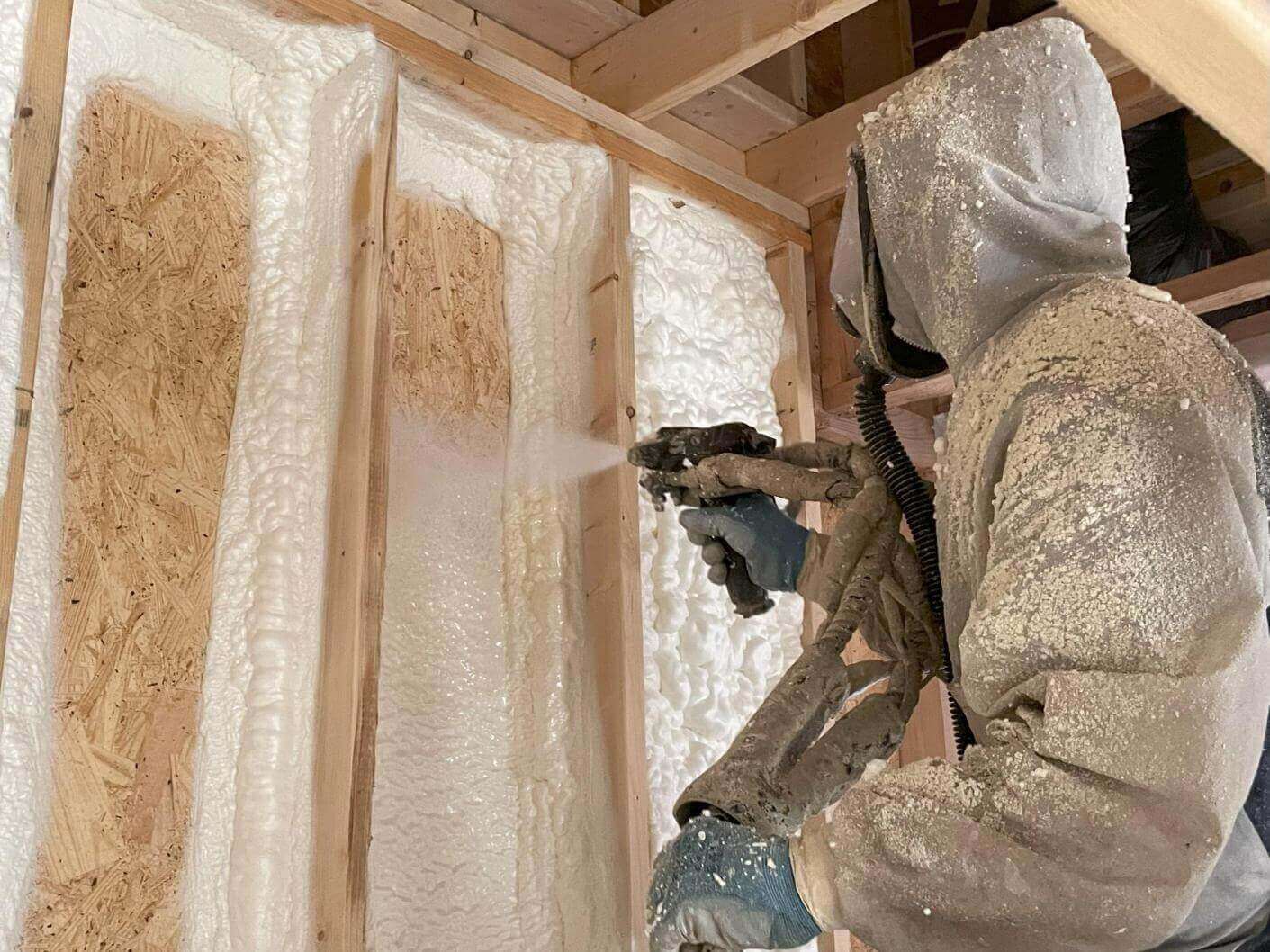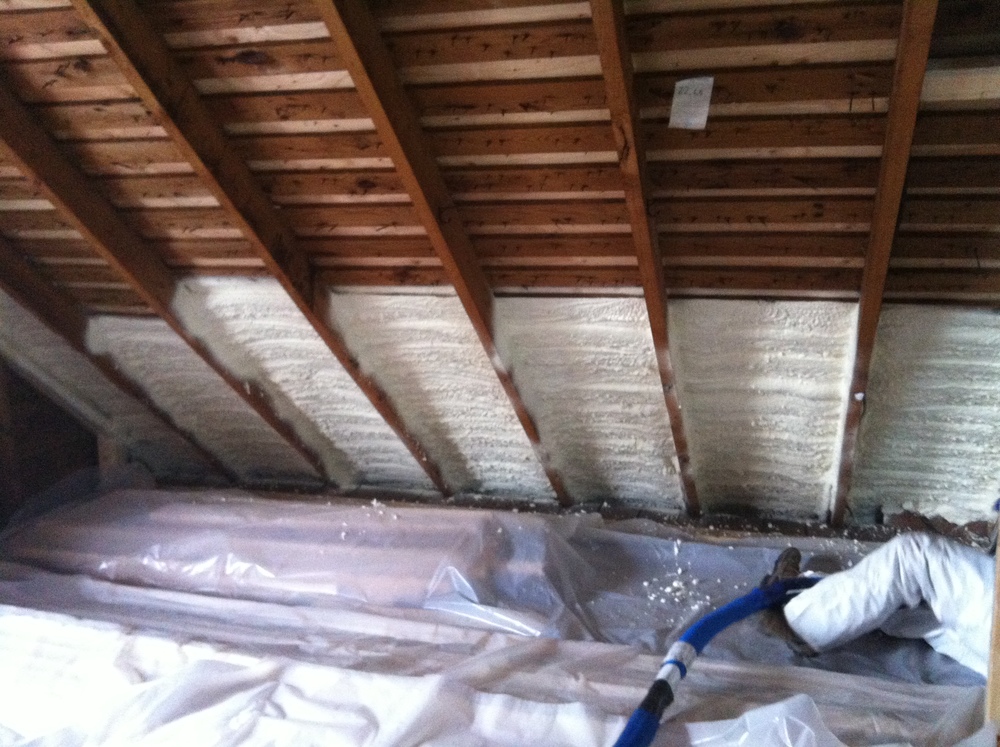Frequently Asked Questions Concerning Spray Foam Installation and Usage
Spray Foam: The Ultimate Service for Air Sealing and Insulation
Spray foam insulation has become a leading solution for effective air sealing and thermal insulation, supplying a special mix of residential or commercial properties that establish it apart from typical techniques. Its capacity to expand and fill gaps makes it particularly efficient in avoiding air leakage, which can dramatically influence power effectiveness. Comprehending the full range of its advantages, installation processes, and comparisons with other insulation types is crucial for making educated decisions. As we explore these aspects, the implications for both brand-new building and constructions and retrofits end up being increasingly substantial. What factors should influence your option?
What Is Spray Foam?
Spray foam is a flexible insulation material that incorporates the concepts of air sealing and thermal resistance to enhance power performance in buildings. Made up mostly of polyurethane or other similar compounds, spray foam is used as a liquid that broadens upon call with surfaces, creating a solid, continuous layer of insulation. This unique residential property allows it to load spaces, fractures, and voids that standard insulation products may ignore, providing a remarkable air seal.
There are two primary sorts of spray foam: open-cell and closed-cell. Open-cell spray foam is lighter and a lot more versatile, supplying outstanding noise absorption and a lower R-value per inch - Spray Foam. On the other hand, closed-cell spray foam is denser, supplying a greater R-value, wetness resistance, and included architectural honesty to constructing elements
The application procedure usually includes specialized devices, ensuring a seamless application that adheres to various substrates, including concrete, wood, and steel. This adaptability makes spray foam suitable for both brand-new buildings and retrofitting existing frameworks. Its capacity to produce an airtight obstacle substantially adds to reducing power usage and boosting interior air high quality, thereby making it a favored choice amongst house owners and builders alike.
Advantages of Spray Foam Insulation
One of the most considerable advantages of spray foam insulation is its phenomenal ability to produce a constant air obstacle, which properly minimizes power loss. Unlike typical insulation products, spray foam increases to fill up fractures and spaces, ensuring that air leakage is significantly minimized. This particular not only boosts energy effectiveness however additionally results in decrease energy costs in time.
Furthermore, spray foam insulation offers superior thermal resistance, adding to a more steady indoor atmosphere. Its high R-value per inch enables for effective insulation in constrained spaces, making it excellent for attic rooms, wall surfaces, and crawl rooms. Moreover, the moisture-resistant buildings of spray foam assistance stop mold and mildew and mold growth, advertising healthier living conditions.
Another essential advantage of spray foam insulation is its sound-dampening qualities (Spray Foam). It efficiently reduces noise transmission in between rooms, developing a quieter and a lot more comfy home environment. The toughness of spray foam also sticks out, as it does not sag or settle with time, maintaining its efficiency throughout its life-span
Exactly How Spray Foam Functions
Recognizing how spray foam insulation functions is essential for appreciating its performance in air securing and thermal resistance. Spray foam insulation consists of 2 primary elements: isocyanate and polyol resin. When these parts are combined, they undertake a chain reaction that causes the product to expand rapidly, creating a thick foam that fills voids, splits, and dental caries.
As the foam increases, it sticks to surfaces, forming an airtight seal that substantially reduces air seepage. This characteristic makes spray foam insulation highly reliable at protecting against drafts and wetness penetration, which can bring about energy loss and damage over time. In addition, the closed-cell variation of spray foam offers remarkable thermal resistance because of its stiff structure, efficiently minimizing heat transfer.
The one-of-a-kind homes of spray foam permit it to satisfy uneven surface areas, making sure extensive coverage and a seamless barrier. Because of this, spray foam insulation not just enhances energy effectiveness but also adds to enhanced indoor air high quality by lowering the build-up of pollutants and allergens. Eventually, understanding the mechanics behind spray foam highlights its role as a premium choice for insulation and air securing in both residential and commercial applications.
Setup Refine Review

Before setup, the room has to discover this info here be properly cleansed and prepped, making sure that surfaces are devoid of dirt, moisture, and debris. This step is crucial due to the fact that pollutants can endanger attachment and total performance. As soon as the area is prepared, the application entails mixing both elements of the spray foam, which broadens upon get in touch with and fills up voids successfully.
Trained professionals must conduct the installation, using customized equipment to guarantee uniform protection and optimum density. Safety and security precautions, including wearing protective gear and making sure correct ventilation, are necessary throughout this procedure. After application, the foam generally remedies rapidly, developing a solid barrier that improves power effectiveness.
Contrasting Spray Foam to Typical Insulation
When evaluating insulation alternatives, spray foam insulation attracts attention in contrast to typical materials such as fiberglass and cellulose. One of the primary advantages of spray foam is its superior air sealing abilities. Unlike fiberglass and cellulose, which can permit air seepage, spray foam increases look at this now upon application, loading crevices and voids to produce an airtight seal. This causes enhanced energy performance, as less heated or cooled air runs away the home, resulting in lower utility bills.
In addition, spray foam offers a higher R-value per inch than traditional insulation kinds, using more effective thermal resistance in a thinner profile. This particular is especially useful in rooms with minimal dental caries depth. Furthermore, spray foam is immune to dampness and mold development, which can be a significant concern with cellulose and fiberglass, particularly in damp atmospheres.
Nonetheless, spray foam insulation typically brings a greater in advance cost than its standard counterparts. Property owners should evaluate this preliminary financial investment against long-lasting power savings and performance advantages. Eventually, while both insulation kinds offer their purpose, spray foam emerges as an advanced solution for modern-day insulation needs, particularly in terms of air securing and thermal efficiency.

Conclusion
In summary, spray foam insulation stands for a highly reliable remedy for achieving optimum air sealing and thermal resistance. Its unique homes, including moisture resistance and sound dampening, make it ideal for various applications in both brand-new constructions and retrofitting projects (Spray Foam). Although the initial costs may be higher compared to typical insulation materials, the lasting advantages, such as substantial power savings and boosted interior air quality, justify the financial investment and emphasize its value in contemporary structure practices.
Spray foam insulation has emerged as a leading option for reliable air securing and thermal insulation, using an one-of-a-kind combination of residential or commercial properties that establish it apart from standard techniques.Spray foam is a functional insulation material that incorporates the principles of air sealing and thermal resistance to enhance power efficiency in buildings.When reviewing insulation choices, spray foam insulation stands out in comparison to conventional products such as fiberglass and cellulose. Ultimately, while visit the website both insulation kinds offer their function, spray foam arises as a more advanced option for modern insulation demands, especially in terms of air sealing and thermal effectiveness.
In recap, spray foam insulation stands for an extremely effective solution for achieving optimal air securing and thermal resistance.